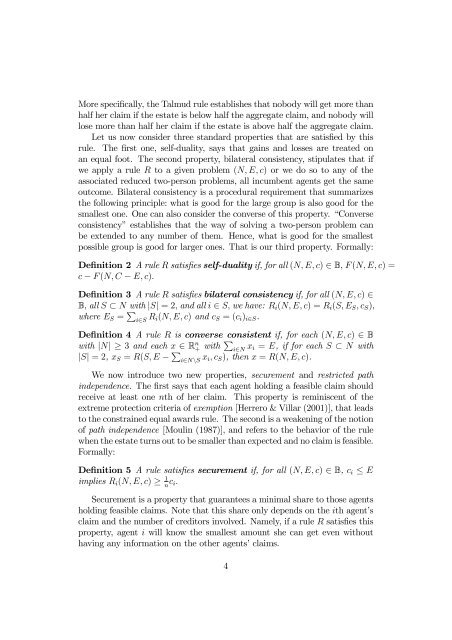THE TALMUD RULE AND THE SECUREMENT OF ... - ResearchGate
Create successful ePaper yourself
Turn your PDF publications into a flip-book with our unique Google optimized e-Paper software.
More specifically, the Talmud rule establishes that nobody will get more than<br />
half her claim if the estate is below half the aggregate claim, and nobody will<br />
lose more than half her claim if the estate is above half the aggregate claim.<br />
Let us now consider three standard properties that are satisfied by this<br />
rule. The first one, self-duality, says that gains and losses are treated on<br />
an equal foot. The second property, bilateral consistency, stipulates that if<br />
we apply a rule R to a given problem (N,E,c) or we do so to any of the<br />
associated reduced two-person problems, all incumbent agents get the same<br />
outcome. Bilateral consistency is a procedural requirement that summarizes<br />
the following principle: what is good for the large group is also good for the<br />
smallest one. One can also consider the converse of this property. “Converse<br />
consistency” establishes that the way of solving a two-person problem can<br />
be extended to any number of them. Hence, what is good for the smallest<br />
possible group is good for larger ones. That is our third property. Formally:<br />
Definition 2 AruleR satisfies self-duality if, for all (N,E,c) ∈ B,F(N,E,c) =<br />
c − F (N,C − E,c).<br />
Definition 3 AruleR satisfies bilateral consistency if, for all (N,E,c) ∈<br />
B, all S ⊂ N with |S| =2, and all i ∈ S, we have: R i (N,E,c) =R i (S, E S ,c S ),<br />
where E S = i∈S R i(N,E,c) and c S =(c i ) i∈S .<br />
Definition 4 AruleR is converse consistent if, for each (N,E,c) ∈ B<br />
with |N| ≥ 3 and each x ∈ R n + with i∈N x i = E, ifforeachS ⊂ N with<br />
|S| =2, x S = R(S, E − i∈N\S x i,c S ),thenx = R(N,E,c).<br />
We now introduce two new properties, securement and restricted path<br />
independence. The firstsaysthateachagentholdingafeasibleclaimshould<br />
receive at least one nth of her claim. This property is reminiscent of the<br />
extreme protection criteria of exemption [Herrero & Villar (2001)], that leads<br />
to the constrained equal awards rule. The second is a weakening of the notion<br />
of path independence [Moulin (1987)], and refers to the behavior of the rule<br />
when the estate turns out to be smaller than expected and no claim is feasible.<br />
Formally:<br />
Definition 5 A rule satisfies securement if, for all (N,E,c) ∈ B, c i ≤ E<br />
implies R i (N,E,c) ≥ 1 n c i.<br />
Securement is a property that guarantees a minimal share to those agents<br />
holding feasible claims. Note that this share only depends on the ith agent’s<br />
claim and the number of creditors involved. Namely, if a rule R satisfies this<br />
property, agent i will know the smallest amount she can get even without<br />
having any information on the other agents’ claims.<br />
4

















